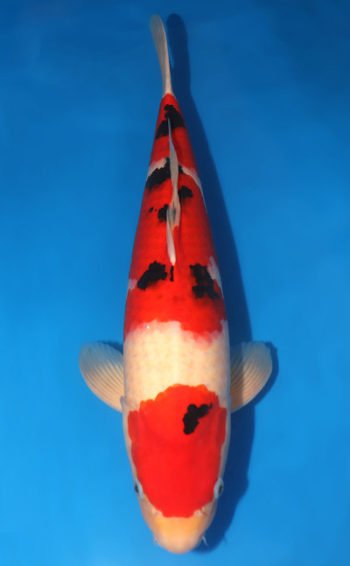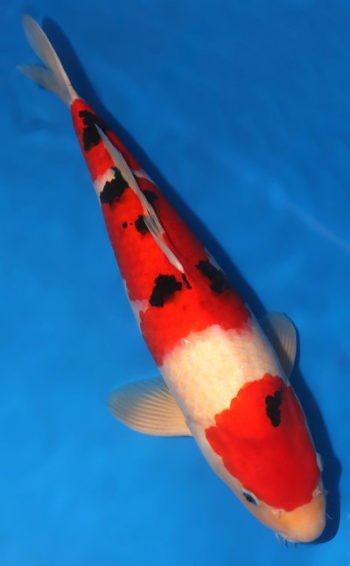Taisho Sanke Koi
Zobacz wszystkie nasze wysokiej jakości ryby koi na sprzedaż i motyle koi na sprzedaż. Oferujemy najlepszy wybór karpi koi w branży. Połącz to z naszą niesamowitą 14-dniową gwarancją przybycia na żywo i możliwością wybrania własnej daty dostawy, a otrzymasz bezkonkurencyjną wartość.
14-DNIOWA BEZPROBLEMOWA GWARANCJA: Oferujemy wiodącą w branży 14-dniowa gwarancja bez zmartwień aby mieć pewność, że możesz robić zakupy spokojnie, wiedząc, że zawsze będziesz objęty ubezpieczeniem.
Hodowca(e): Arowana Raj Farm
Seks: Męski
Rozmiar: 19,49 cala
Różnorodność: Taisho Sanke
$160.00 Original price was: $160.00.$150.00Current price is: $150.00.
Description
Taisho Sanke Koi Fish For Sale
Taisho Sanke Koi, the Koi fish hobby can be as addictive as a video game for a teenager. They are a ryba of beauty and diverse colors. These spectacular fish can show their personality at meal time. Koi are often overly excited when you feed them and sometimes will display jumping and be trained to eat from your hand. They are omnivorous fish, eating both plants and animals (mostly small crustaceans.) Similar to most nutrition plans, Koi will do best with a properly balanced diet.
When properly cared for in an ideal environment, the Koi will possibly outlive their owners. An average Koi lives 23-30 years, but the oldest known Koi fish lived for 226 years. They range in sizes of 2-3 feet and can weigh up to 35-40 lbs. They are a hardy, cold water fish and will flourish in a temperature range of 59-77 degrees F (15-25 degrees C).
Selecting Taisho Sanke Koi
When selecting a Koi fish to raise and possibly show, it is best to consider many factors such as the color, pattern, body, and overall health. Look for a healthy fish without any body deformities or missing fins. The color should be even and pure with a balanced pattern. When judging the body of a Koi, the head should be symmetrical and in proportion to the body.
An easy way to gauge correct proportion is by looking for a smooth transition of the gill plate that divides the head and body. The best Koi shape is larger at the middle with a gradual tapering towards the head and even more so at the tail. Take into consideration the size of the snout and fins.
For the Sanke variety, the white (shiro) body should be a thick, milky white and not have any yellow tinting or blemishes. The red (hi) markings should be solid and evenly colored and the edges (kiwa) should be defined. The hue can range from a bright orange to a deep red tint. The black (sumi) markings should be solid with clearly defined edges as well. The spotting of dark blue or gray can change into black on a young Koi as it matures. Try to avoid Sanke with any black on the head.
Sanke Variety Koi
A (red) hi pattern that moves from the head to tail continuously is known as an Aka Sanke and are less desired. A Tancho Sanke has a red round patch on the head, with no other red on the body. This Sanke variation is highly sought after in Japan because of the similarity in appearance to the Japanese national bird. If there are red markings on the body as well, then it is known as a Maruten Sanke.
The best way to determine what the high quality Koi looks like is to become familiar by looking at photos of Koi, by joining a Koi club and attending Koi shows. With time, research, and experience, any hobbyist will be able to select the best Koi for their pond and enjoy them for many years.
Przewodnik po pielęgnacji karpi koi – sześć rzeczy, które warto wiedzieć o karmach koi
- Poziom doświadczenia: Średniozaawansowany
- Rozmiar: Koi rosną do 36 cali (91 cm) długości
- Długość życia: mogą żyć ponad 50 lat i rozwijać się w szerokim zakresie temperatur wody
- Temperament: Na ogół są spokojne, ale mogą łowić wolniejsze ryby
- Pochodzenie: to rodzaj karpia pochodzącego z Japonii
- Czy wiedziałeś: Koi mogą nauczyć się rozpoznawać i przyjmować jedzenie od swoich domowych rodziców?
Jak założyć akwarium mojego karpi koi?
- Koi szybko rosną i stają się bardzo duże. Przechowuj dojrzałe koi w odkrytym stawie o głębokości co najmniej 3 stóp, z co najmniej 50 galonami wody na rybę.
- Młode koi można trzymać w domu w akwarium o pojemności co najmniej 29 galonów.
- Umieść akwarium w cichym miejscu, z dala od bezpośredniego światła słonecznego i przeciągów.
- Przykryj akwarium okapem, aby ograniczyć parowanie i rozpryskiwanie oraz aby ryby nie wyskakiwały.
- Aby przenieść nowe koi do akwarium, zanurz je w wodzie w torbie na około 10 minut, aby mogły zaaklimatyzować się do nowej temperatury wody.
- Jeśli wprowadzasz koi do istniejącej ławicy w akwarium lub stawie, poddaj nowe ryby kwarantannie w oddzielnym zbiorniku wodnym przez 2 do 4 tygodni, aby upewnić się, że są zdrowe.
- W dniu przeprowadzki użyj siatki, aby przenieść koi, aby stara woda nie zmieszała się z nową.
- Niezależnie od tego, czy żyją w domu, czy na zewnątrz, dodaj nie więcej niż 3 nowe koi na raz.
Ciepło i światło
Outdoor Koi są odporne i zimą zapadają w stan hibernacji pod lodem, o ile ich staw jest wystarczająco głęboki, aby nie zamarznąć całkowicie. (Nie przetrwają w twardym lodzie.)
Twój staw koi powinien być częściowo zacieniony.
Kryte koi preferują wodę o temperaturze od 65 do 75 stopni Fahrenheita.
Zainstaluj lampę w wewnętrznym akwarium, aby oświetlać je przez 8 do 12 godzin dziennie.
Temperatura wody
Koi są dość odporne na temperaturę — zimą mogą nawet hibernować pod lodem. Tylko upewnij się, że twój staw ma co najmniej metr głębokości – w przeciwnym razie może zamarznąć na stałe, a koi nie są takie twarde. Kiedy żyją w pomieszczeniach, koi wolą zimną wodę – od 65 do 75 stopni F (18 do 24 C).
Jak zachować zdrowie karpi koi?
Jeśli wydaje się, że twoje koi na świeżym powietrzu nie je zimą, nie martw się; to normalne, że przestają jeść w temperaturze poniżej 40 F. Pamiętaj, aby skontaktować się z weterynarzem, jeśli zauważysz którykolwiek z tych objawów:
- Niezwykły wzór pływania
- Szczupłość lub zmniejszony apetyt
- Obrzęk brzucha
- Zapalona lub przebarwiona skóra lub płetwy
- Płetwy zaciśnięte na bokach ciała
- Skrobanie ciała na skałach (flashowanie)
types of koi fish, koi fish, koi fish price, koi fish pond, koi fish meaning, koi fish for sale, koi fish drawing, koi fish care, koi fish for sale online, butterfly koi for sale, koi fish for sale near me, big koi for sale, buy koi fish cheap, koi fry for sale usa, types of koi fish, koi fish for sale, High Quality Koi, Coy fish, coe fish, showa koi, kohaku koi, tancho sanke, showa fish





Reviews
There are no reviews yet.